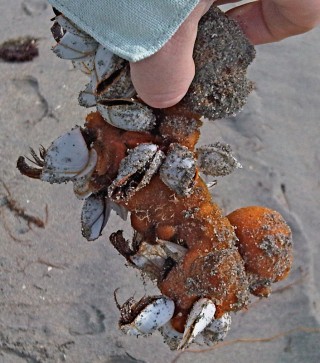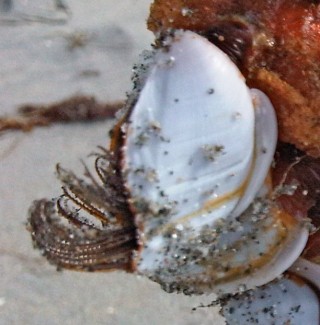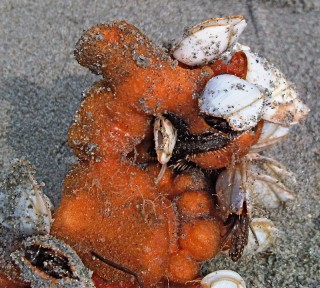Jellyfish and hydrozoans are only one type of animal that gets washed up on the beach during our easterlies. During our explorations last weekend Marcella ran across a colony of goose barnacles that had washed up as well:
They’re attached to an orange substrate that reminds me of a sponge, but I know next to nothing about poriferans, so I can’t get much further with that (I had thought it was an agglomeration of red sponge, Haliclona rubens, but the color is wrong and they’re usually more fingerlike than clumpy).
But there are other, more readily identifiable organisms attached to them: Goose barnacles (Lepas anserifera). These are harmless animals that resemble mollusks (the shells sure look a bivalve shell, don’t they?), but that are in fact arthropods: sessile crustaceans, to be somewhat precise. You can see their jointed legs (arthro-pod) poking out of their shells; they use them to gather food from the water:
Sorry for the blurriness of the pix; I have to remember to bring a real camera on these excursions. The cellphone camera just doesn’t cut it, although it does allow for pix where I would have had no pix at all were it not for it, so… “It’s a poor workman who complains of his tools.” Grumble gripe mumble mumble.
Lepas, according to Langstroth and Langstroth (why do the best beach and ocean guides seem to be written by husband and wife teams?), are pelagic species. They settle “on floating objects such as logs, bottles, ships, and…fishing floats” and go about making a living with their feathery thoracic legs, which “rhythmically gather in suspended food particles and may enhance respiration by creating water currents around the body. Lepas feeds on midsized planktonic organisms; in the laboratory it will even take animals larger than itself.”
When we flipped the whole assembly over, we noticed that there was a worm of some sort as well. It looks like a polychaete worm, but with over 9000 species worldwide, and only a few photos in any of my guides, I can’t even begin to think what it might be…
So there you have it: one animal of three identified for you. Just goes to show how much there is to know out there…



